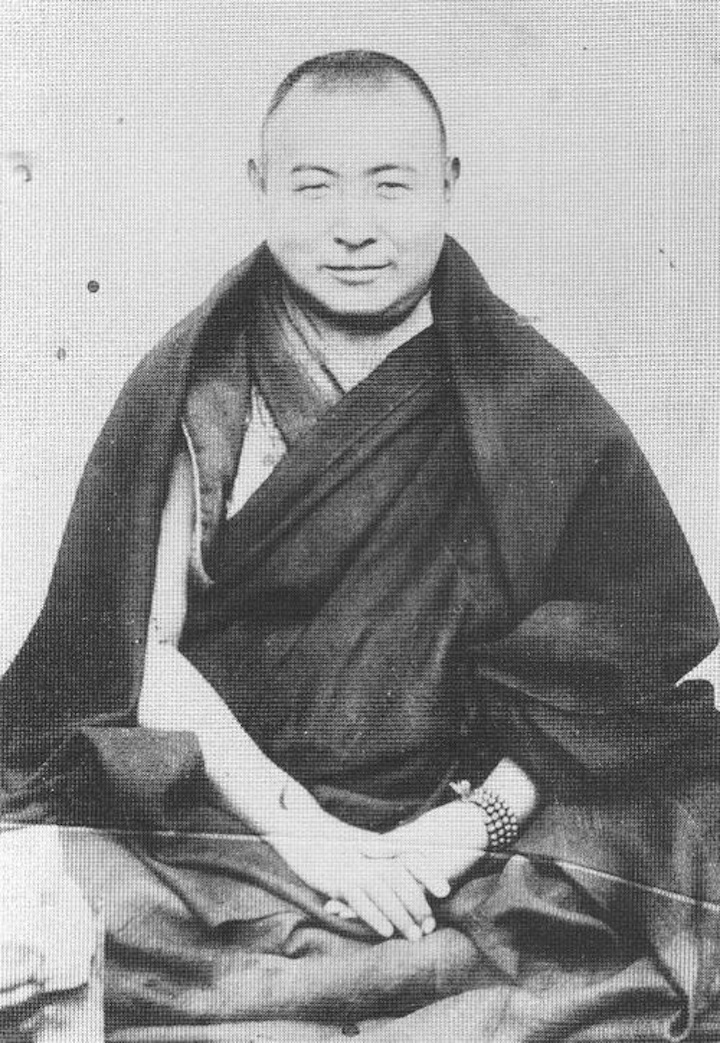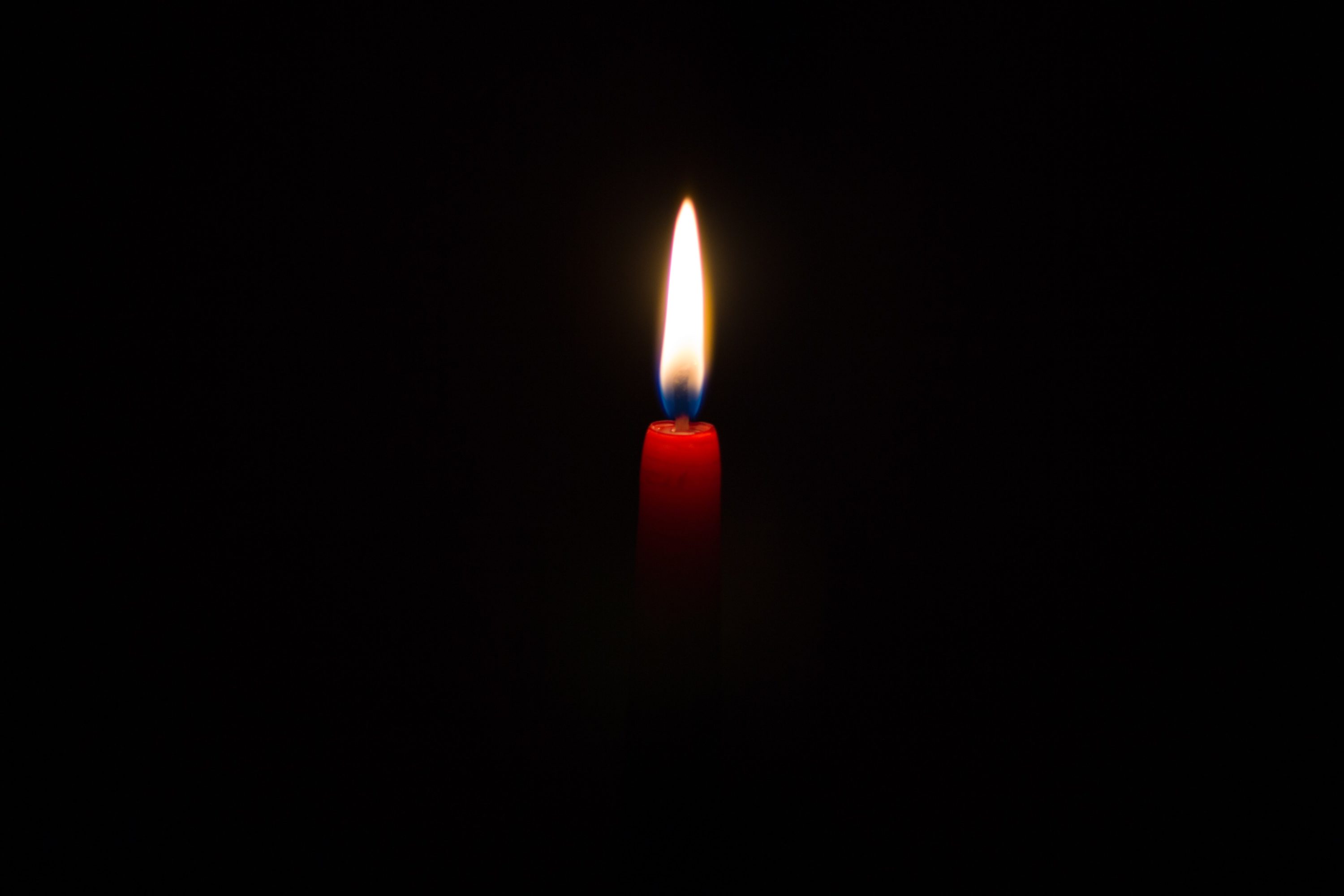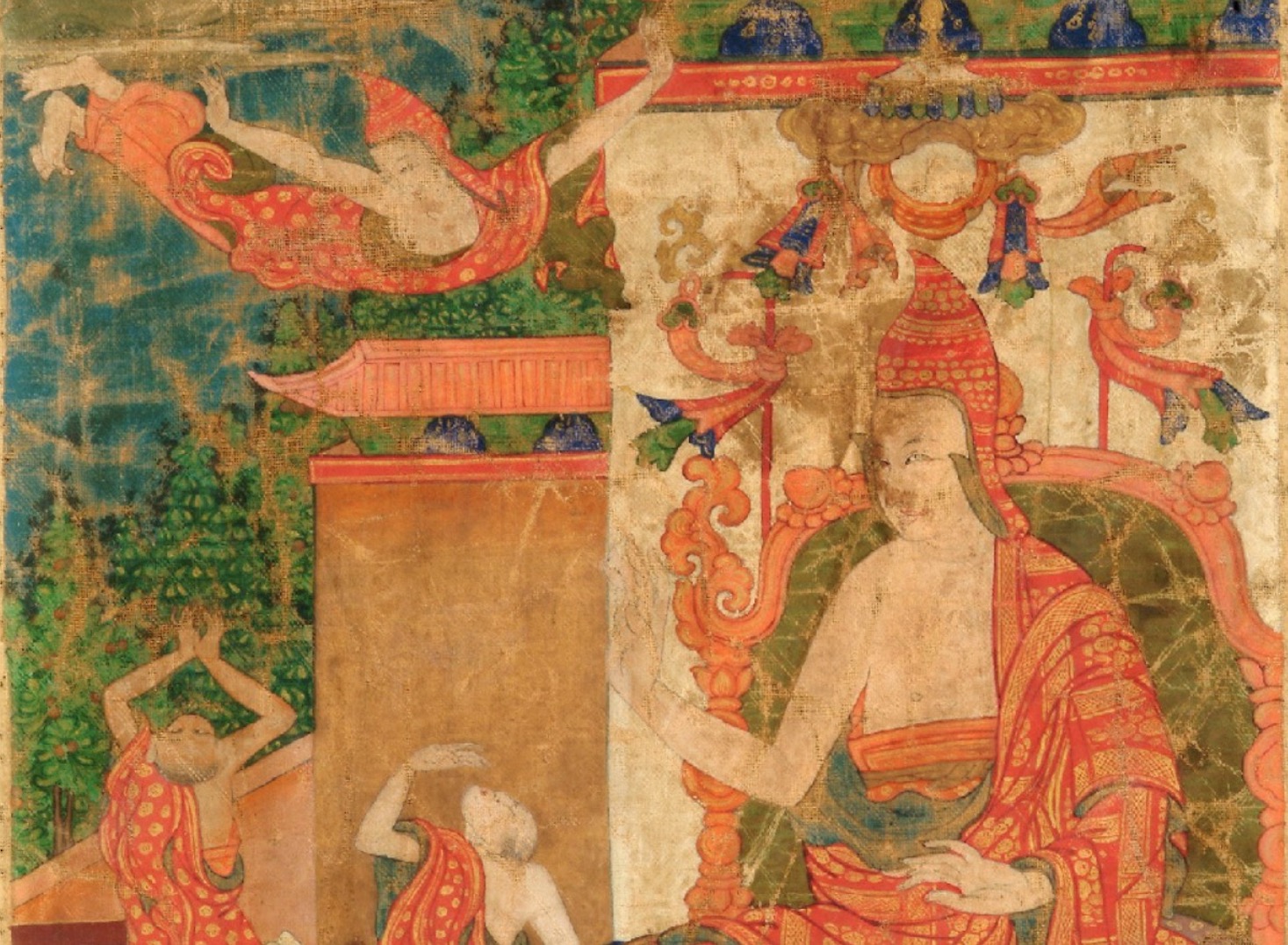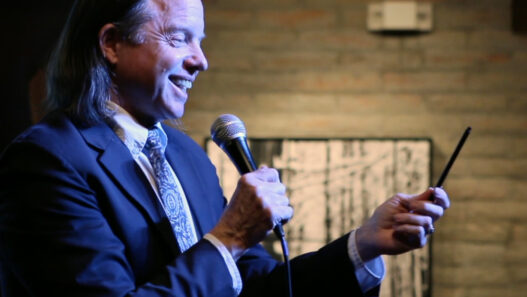Hi, this is Geshe Michael Roach and welcome back to the lam rim (LAM RIM), “Steps on the Path to Enlightenment”. And we’re continuing this text—a very famous book. I think it’s the greatest book ever written, in any language. And this is by Pabongka Rinpoche, who lived 1878 to 1941. He was one of my teacher’s teachers, and he gave this amazing lecture for twenty-four days near the capital of Tibet, Lhasa.

And he taught this amazing instruction book on how to reach enlightenment, all the steps you have to do. So it’s a very cool idea—lam rim. It means, “Look, just do this, then do this, then do this, and then do this, and then suddenly you’re enlightened, and you’re a Buddha and you can help billions of people at the same time.” So this is what we’re doing, and we’ve been going for about ten years now. We’re working our way slowly through the book. We’re enjoying it. We’re enjoying the taste of this ancient wisdom, like a fine wine. We’re just taking our time and we’re going to enjoy this ancient wisdom.
If you’ve been following the lam rim, welcome back. If you’re new, don’t worry about it; just jump in and we’ll just go ahead. If you took some of the early lam rim courses but you got busy and you had other things to do, then welcome back. And we’ll just keep going. It’s my intention to teach this incredible spiritual guide slowly and nicely, and then we just finish when we finish. We’re on our thirty-sixth lam rim retreat. This is the thirty-sixth time I’ve taught this. We’ve been doing about seven to ten days for each retreat—live, and now on the online world, we’re going to be doing fifteen episodes for this lam rim of about half an hour each, and I’ll be going through this text.

I like to call this retreat, number thirty-six, “Love in the Days of the Virus.” So these are the days of the virus where I am and I think for everyone in the world right now. These are the days when the virus is strong in the world and it’s a new world for all of us. It’s something we couldn’t imagine a year ago. And we live in a very unusual time. Things are changing fast. Life is changing fast. There are many dangers, many things to be afraid of, and it’s very important, I think, in these days of doubt, or worry, or feeling fear about the future, I think it’s very important that we have love. And what kind of love is that?

You can think of the whole world in blackness, in darkness, and someone lights a candle or something and there’s this little light struggling against the whole world of darkness. You can think of it that way. You could think of it that way. “Is that what you’re talking about Geshe-la? Is this the kind of love that you’re talking about? I’m going to be a small light in the darkness of the universe, in the darkness of this world with the virus?” And I say, “No, that’s not what I’m talking about.” And then you say, “Well, are you talking about a big light, like the sun, comes up over this world and the whole world is lit up by this sun.

Is that the kind of love you’re talking about? Like the virus is like the darkness, and then the sun comes up. And then in our love—the love of all of us—could change this darkness?” And I say, “No, no—that’s not the kind of dark… that’s not the kind of light I’m talking about. That’s not the kind of love I’m talking about.” And then you say, “Well, what kind of love do you mean?” And I like to call it “using the sun on a ketchup stain.” So in this first image here, you can see a lady. She’s eating a veggie burger. We have a great restaurant across the street—you can still get a veggie burger. You call them, they bring it out in front of the restaurant. And they have a wonderful veggie burger.

And so this lady went and bought a veggie burger. And she put a lot of ketchup and mustard on it. And she’s eating it and—you know what happens. The ketchup comes out. A big clump of ketchup comes down and it lands on your blouse and then suddenly you have this incredibly big red stain on your blouse. And then you’re thinking, “How can I clean this stain?” And I think of the stain is like the virus, is like the Covid virus in the world. This like a ketchup stain and everybody has this stain on their blouse. And they’re like, “How can I get rid of this virus?” And then I like to imagine that this lady went to the—I don’t know—spaceship… we call Kennedy Space Center, and she went there, and she said, “Can you take care of the stain on my blouse?” And then they say,”Yeah! We have a service. We can clean it for you. We can get rid of this stain. We can kill the virus. We can get rid of the virus.” And then she says, “Okay.” And she changes her blouse she gives them the blouse. And in the second picture here and you see they put the blouse in the space shuttle and they’re sending it for cleaning.

So her blouse was put in the space shuttle and they shot it, as you can see, towards the sun. And then the space shuttle approaches the sun with the blouse with the ketchup stain on it, and then when they get close to the sun, they fly into the middle of the sun, which is twenty-five million degrees Fahrenheit. I just checked it online. The spaceship somehow gets into the middle of the sun, and it’s twenty-five million degrees Fahrenheit, and then they open the door, and they throw out the blouse. And just try to imagine a single woman’s blouse thrown into the middle of the sun. And try to imagine that kind of light. So think of the ketchup stain as this virus in the world right now, and think of the middle of the sun
as the fire.
And what we’re going to talk about in this lam rim retreat, is a love which is like the middle of the sun. It’s a love whose power is like the middle of the sun. And you take this virus, which is a big problem in our world right now, and you put it in the middle of the sun. Like a little piece of ketchup stain on a blouse, and you put it in the middle of the sun. That’s the kind of love we’re going to talk about. We’re talking about a love which would [snaps fingers] burn up a billion viruses in a second. We’re talking about this kind of love.
And it’s hard to imagine. It was hard for me to find a good image. Maybe my image is strange but, imagine the power at the middle of the sun, and then imagine one small virus trying to fight against this power. And this is what we’re talking about.

And it’s hard to imagine. It was hard for me to find a good image. Maybe my image is strange but, imagine the power at the middle of the sun, and then imagine one small virus trying to fight against this power. And this is what we’re talking about. In this lam rim, we
will try to find this kind of love in the days of the virus. This kind of love which will remove the power of the virus in this world. And it will. And it can. And we can learn it together. This book is going to help us learn together how to burn up the virus with this kind of love. And even that example is too small, but it’s the biggest one I can think of right now. So we’re going to work on that kind of love.
This course will have two parts. In the first part, we’ll go through the lam rim, we’ll go through the steps on the path, and we’ll go… I like to do it word-by-word. I like to pass it on. One of my goals in these courses is to pass on what my teacher taught me from the original language. So my teacher taught me this text for thirty years. He taught it to me three times, and each time—I don’t know—each time took seven or eight years, and he taught it slow, and we enjoyed it. And we didn’t think about reaching the end of it. Actually every time he reached the end, he started over again. So it was more the experience, you know? We weren’t trying to finish the book; we were trying to live inside the book, and then keep living inside the book. So that’s kind of what we’re doing.
[su_icon icon=”icon: link” color=”#ff1259″ size=”20″ shape_size=”12″ url=”https://youtu.be/oDi5ML8Ek1w?t=10m12s” target=”blank”]Video[/su_icon]So now let’s start. We’re going to be doing the book, on one hand, and then we’ll be doing meditations together. Now the meditations are based on a very, very famous book written in Sanskrit about 1,300 years ago in India by a master named Shantideva.
[su_icon icon=”icon: link” color=”#ff1259″ size=”20″ shape_size=”12″ url=”https://youtu.be/oDi5ML8Ek1w?t=10m34s” target=”blank”]Video[/su_icon]
And I know a lot of you know the story of Shantideva. And it’s a very, very beautiful story. He was a great, great master who was living in a monastery and everybody thought he was just a goof off. People thought he was lazy. But secretly, he was doing great, great practice in developing love and developing an understanding of emptiness, and he was living this kind of life secretly. And then there’s a long story. I won’t tell it to you today. If you’re interested, you can study the ACI courses. I think it’s 10, 11, 12. And you can study the “Guide to the Bodhisattva’s Way of Life”—this great book of Shantideva. So we’re going to use Shantideva’s book to do a meditation on love. And so as we go through this lam rim, we’re going to be doing special meditations on love. And we’ll do that separate from these classes, and we’ll be taking it from Shantideva’s book.
Now, it’s tradition when you start the first episode of a new lam rim course that you tell your audience, you know, where are we in this book? Every great spiritual classic has a sab che [SA BCAD]. sab che means a certain outline. And we follow certain steps through the book. And we’re following certain ideas through the book. So it’s traditional when we start again with a new course to talk about where we are in the sab che. How far have we gotten in this book? Where are we in the sab che? So I thought I would go through the outline with you and tell you where are we in the whole book, okay?
So this book basically has three different parts. Three very, very famous parts. It’s called (1) steps of the path for people of small capacity, (2) steps of the path for people of medium capacity, and then (3) steps of the path for people of great capacity. And people of great capacity, as as some of you know, these are the bodhisattvas. Their motivation is to reach total enlightenment. They would like to reach a body in which they could sit in a billion worlds at the same time, and teach people and share with them the way to happiness. And that’s kind of the sun I’ve been talking about. If you study this book well, if you study these courses well, if you do the meditations well, then you can reach the bodhisattva’s state of mind. It’s called bodhichitta.
And in its highest form, when a person reaches bodhichitta, they can perceive billions of planets at the same time, or in a short time. Within a few minutes’ time in this world, they can perceive…they can visit, billions of worlds and they can get to know the people and all the small creatures on each of those worlds. Within ten or twenty minutes, they can they can make this journey to billions of worlds. And their love is so powerful—we’re not talking about love for one person, or love for your country, or even love for your world. We’re talking about a love that you can reach in your lifetime, which can reach a billion worlds at the same time, and a love which can meet every living thing—every person on a billion worlds, within twenty minutes and interact with each of them directly, and pour love on them, shower love on them, and take care of them, at the same time.
[su_icon icon=”icon: link” color=”#ff1259″ size=”20″ shape_size=”12″ url=”https://youtu.be/oDi5ML8Ek1w?t=15m10s” target=”blank”]Video[/su_icon]And that kind of love is like the middle of the sun. And then the virus that in this world is a very, very, very small thing; it’s like one atom in the middle of the sun or something. It’s only a small thing. The the whole virus situation affecting seven or eight billion people right now in this world is a small thing compared to that love. We’re going to try to reach a kind of love that could burn that virus, just like ketchup on a blouse.
This motivation to become this person who can visit a billion worlds is based on a sort of a lesser motivation. And that motivation is, “I, myself, would like to reach nirvana. I would like to reach a place in my life where I don’t have to suffer anymore. I would like to reach a place in my life where I am free of all pain and especially the pain of negative emotions. I would like to reach this place.” So that’s called… people of medium capacity would like to reach nirvana. Nirvana is different from enlightenment. Nirvana is a place you reach where you have no negativity. No negative thoughts at all. You’re still in a body, you still have a mind, but your mind is totally happy. Like a personal nirvana. So people who want to reach a billion planets and help people, it has to be based on your personal nirvana. You’re going to have to reach this personal nirvana to be able to travel to a billion worlds. The billion worlds traveling depends on reaching this nirvana.
And this nirvana depends on the goal of the lam rim we call “people of small capacity.” They’re just worried about after they die. And I guess this kind of awareness has come to this world this year. It’s sort of amazing. The whole world is thinking… you know, we’re all wearing masks. I took off my mask to teach. The whole world is thinking, “I need a mask. I have to put on a mask because I might die. If I don’t wear this mask, I might die.” And then of course, some people are thinking…most of us, I think, “Well, what would happen to me after that? What would happen to me if I died? Where would I go? What would happen to me?” And that’s the motivation which is the foundation for the wish for nirvana, which are the foundation for thinking like a bodhisattva—”I would like to help everyone.” Worrying about where you’re going to go after you die, is the foundation of reaching nirvana, and together they are the foundation of this higher desire to become a Buddha to help people on billions of planets.
[su_icon icon=”icon: link” color=”#ff1259″ size=”20″ shape_size=”12″ url=”https://youtu.be/oDi5ML8Ek1w?t=18m28s” target=”blank”]Video[/su_icon]So why are we talking about that? We reached this part in the lam rim. After ten years of work, we are actually close to the end of the second part. We are close to the end of the instructions for reaching nirvana. And we’re actually going to finish that section during this lam rim program. This month, we’re going to finish the section of how to reach nirvana. And then we’re going to have this cool transition into the whole teachings on bodhisattvas’ way of life—how to be a bodhisattva.
So we’ll be meditating on the bodhisattvas’ way of life and the lam rim is going to start into what’s it like to think like a bodhisattva. So right now we’re in this medium motivation, “I want to take care of where I’m going to go after I die. I want to make sure that I can reach nirvana so after I die, I know where I will go and I will not suffer.” Thinking about that—”removing my negativities forever”—is the second level. Now that second level has two parts. First is called what kind of body and mind do you need to get out of this circle of pain, this wheel of life? We covered that already, and then we said, “Well, what kind of path do you have to follow? What kind of spiritual path do you have to follow to reach nirvana?” And we’re in the middle of that. We’re still in that and this is where we’re going to start. And now we’re ready to start the text.

I’m going to show you this first IDIM, or this first idea image. And we have a middle-aged guy helping his father, maybe? He bought the father a computer, and the father doesn’t really know how to use it. This happened to me, actually. I had a chance to meet one of the highest teachers in the world, personally, and I offered them a computer, but then I had to help them learn how to use it. So let’s go to the text. Why does this picture relate to the text? I’m going to read the Tibetan. Don’t get nervous. Don’t think it’s stupid. Don’t think, “Oh, are they going to ask me to learn a whole language? Do I have to learn a whole language?” No, you don’t have to learn a whole new language. I am planting seeds in your mind for next life, okay? So don’t worry about it. When a teacher wants to plant seeds in your mind for your next life, then just relax and let them in, okay? Just open your heart, open your mind, say “Okay, Geshe-la. Say this weird Tibetan language stuff, and I’ll try to keep my mind open. And I understand you are making plans for my next life.” And that’s what we’re doing. So I will read the Tibetan with you and I’m not trying to force you to learn a new language. It’s too much. I’m putting small bombs in your mind for next life. Small kindness bombs, okay? Alright.
[su_icon icon=”icon: link” color=”#ff1259″ size=”20″ shape_size=”12″ url=”https://youtu.be/oDi5ML8Ek1w?t=22m15s” target=”blank”]Video[/su_icon]lappa sum ne sherab dang… [BSLAB PA GSUM NAS SHES RAB DANG,…] ting-ngen-dzin gyi lappa rang chak le dangpo… […TING NGE ‘DZIN GYI BSLAB PA RANG CAG LAS DANG PO…] …pe… […PAS…] …trel du lak tu lon ka yang.
So, [‘PHRAL DU LAG TU LON DKA’ YANG] there are three trainings in Buddhism. Buddhism has three famous things that we have to master in this life. The first of them is kindness—being nice to other people. That’s why I have this image or this photograph of a person, maybe he’s helping his father, just a small kindness. The dad doesn’t know how to start this new computer. The dad’s hoping that the son will help him to start this new computer and the son is taking his time. He’s very busy, he works in a big office, he has lots of responsibilities, but he’s being kind. He’s showing kindness to his father. And you can say this is “morality”. This is the training of morality.
The second training is called ting ngen-dzin [TING NGE ‘DZIN], ting-ngen-dzin gyi lappa [TING NGE ‘DZIN GYI BSLAB PA]. And ting-ngen-dzin gyi lappa means to train yourself in meditation, to get good at meditation. And I repeat to you the simple, simple trick of an old man who tried his whole life to meditate well. There’s a trick, there’s a simple method. Start today. Do ten minutes of meditation. We’re going to do it together. And then do ten minutes of meditation every day for the next week. When you get to, I don’t know, Saturday or Sunday—whatever is a day off in your country—then increase by one minute. Every week, increase by one minute. So in the second week, you’re going to do eleven minutes of meditation. Keep that up for one year, and by the end of the year you’ll be meditating well for an hour. If you try to meditate for an hour at the beginning, you will fail and you won’t learn to meditate. So please, ten minutes of meditation. Just ten minutes. And we’re going to do a meditation together. And then every Saturday or Sunday, every weekend, add one minute. Then you’ll have the second training.
The third training is wisdom, it’s emptiness—understanding why the pen is not coming from the pen, which in Buddhist language is called the pen is not the pen. The pen is not the pen. But what it means is, the pen is not a pen that’s coming from the pen. “Well, is there a pen there?” Yes. “Well, what kind of pen is there?” Oh, there’s a pen coming from me—that’s dependent origination. There’s a pen which is coming from my seeds, but there’s no pen which is coming from its own side. That’s emptiness.
So there are three trainings. We can say understanding emptiness, and then learning to meditate ten minutes—start with ten minutes. If you stopped meditating since the last lam rim, which I also stopped, okay? Let’s start again. Let’s start with ten minutes, and we’ll add one minute. And then good behavior towards others, being kind to other people. By the way, these three are the fire at the middle of the sun which will burn the virus. These three trainings are the fire in the middle of the sun which we can really use in this month to burn the virus—to burn it up like a ketchup stain in the middle of the sun.
Okay. le dangpo pe trel du lak tu lun kawa—[LAS DANG PO PAS ‘PHRAL DU LAG TU LON DKA’ BA] Of these three… okay, you guys ready? Twenty dollar question. I have three friends here. You ready? You want to make twenty dollars? I’m serious! This is the real thing. One of these you can start doing any time. Two of them take a little bit of training—you have to have special conditions, special training. One of them we can start in the next ten minutes. Twenty dollars. [Kindness] Yeah, kindness. Twenty bucks for her, okay? Who’s the banker? Seiji’s the banker. Okay, I owe you twenty bucks. Yeah, this one we can all start any time. You don’t have to have a meditation room, you don’t have to have some complicated book about emptiness. Any of us can start any time to be kind to other people. We have other people, we just be nice to them. So he says lak tu lun ka [LAG TU LON DKA’]—it’s difficult to start meditating and doing emptiness meditations just in the next five minutes, but you can always be nice to somebody.
rang rey gyu la yu…[RANG RE’I RGYUD LA YOD…] …nge dang lak tu lun nge kyi tokpay…[…NGES DANG LAG TU LON NGES KYI RTOGS PA’I…]…tenpa [BSTAN PA]—we have the teachings in our hand. Okay, that’s the name of this book, right? I will put liberation into the palm of your hand and it’s right here—tokpay tenpa. If Nick was here I’d offer him twenty bucks, but okay, there’s a lung gyi tenpa [LUNG GYI BSTAN PA] and a tokpay tenpa. Tim, you want to try? lung—the teaching in the form of lung, and the teaching in the form of tokpa [RTOGS PA]. Yea, split—ten bucks each. You keeping track?
[su_icon icon=”icon: link” color=”#ff1259″ size=”20″ shape_size=”12″ url=”https://youtu.be/oDi5ML8Ek1w?t=28m09s” target=”blank”]Video[/su_icon]It’s not that Buddhism is teaching you how to be nice to other people. Being nice to other people is Buddhism.
Yeah, the whole Buddhist teachings are divided into ideas and books. We can say ideas and books. Ideas in your head and books, okay? Teachings, physical teachings. Which one is kindness? Kindness is which of those? Is it a state of mind or is it a book? Yeah, it’s a state of mind. So he says here, you want these state of mind breakthroughs? Well maybe you could start with being nice to other people. And that is Buddhism. So, it’s not that Buddhism is teaching you how to be nice to other people. Being nice to other people is
Buddhism. Alright, cool. tenpa rang…[BSTAN PA RANG…] …gyu kyi so-so tarpay tsultrim yinpe— […RGYUD KYI SO SO THAR PA’I TSUL KHRIMS YIN PAS] And we all have that kind of teaching; it’s called Vinaya. It’s called pratimoksha– basic good behavior towards other people.
We all have… for example, the ten guidelines. Okay, for zero dollars… because you should know it! What’s the first one? Don’t kill other people or creatures. Second one? Don’t steal their… respect other people’s stuff. Let’s say it positive way, okay? Respect life, respect other people’s things. Protect life, respect other people’s things. Third one? Respect other people’s relationships. Don’t mess around other people’s partners. Speak truth. Always speak the truth. Fifth one? Bring people together with your talk—always try to bring people together. Number six? Speak nice to people. Say nice things to people. Don’t don’t say hard things to people. Number seven? Don’t blah, blah, blah, blah, blah. “Did you hear what Tom said today?” “Did you hear the virus?” It’s important to know what’s happening with the virus, but to talk about it all day is a waste of your time. Number eight? Be happy when other people get something. Number nine? Be sad when something bad happens to people. Number ten? The pen—okay, good, yeah.
So he says, here in the first paragraph, he says we always have this teaching available to us, we can always be nice to other people in ten different ways. And, now, the next thing he says is sanggye kyi…[SANGS RGYAS KYI…] tenpa yu me gendun la rak le she—[…BSTAN PA YOD MED DGE ‘DUN LA LAG LAS ZHES] if there’s a person in the world who is trying to do these ten good things for other people, then we can say Buddhism is in their room. Buddhism exists there. If there’s a person trying to keep these ten good deeds very, very basic Buddhism—very, very basic. If there’s one person trying to do those ten things—trying not to hurt other peoples’ life, trying not to lie, trying not to hurt other people’s things— if there’s one person in the whole city, then we can say Buddhism exists in that city. That’s very cool.
rak le shepa’ang de yin shing… [RAG LAS ZHES PA’ANG DE YIN ZHING…] …dompa gong ma nyi kyi shi’am nu tabu’ang so… […SDOM PA GONG MA GNYIS KYI GZHI’AM SNOD LTA BU’ANG SO…] …tar yin—[…THAR YIN] and these ten are the basis of the two higher set of vows. There are three sets of vows. The lowest one—the foundation one—is not hurting other people. The second set of vows, bodhisattva vows, and then we have secret vows. So, being nice to other people—like this guy is taking care of his dad, helping him, is the foundation of all Buddhist practice.
[su_icon icon=”icon: link” color=”#ff1259″ size=”20″ shape_size=”12″ url=”https://youtu.be/oDi5ML8Ek1w?t=32m19s” target=”blank”]Video[/su_icon]Why are we talking about that? We’re talking about love in the time of the virus. We’re talking about bringing the sun into a whole universe of darkness. Light of the sun. And the foundation of that is these ten ways of being nice to other people. That’s the whole foundation. In the next episode, we’re going to talk about the idea of a holder of the Dharma. Dharma holder, holder of the Dharma. This is a very, very famous idea. It’s called tenpa dzin [BSTAN PA ‘DZIN]—holder of the teachings. And how can you and I become a holder of the Buddha’s teachings? How can we be a transmission of the Buddhist teachings? How can we be a Dharma keeper? How can we become a Dharma keeper? So, we’ll talk about that in the next episode.
And thank you for starting the lam rim again. It’s a lot of fun for me—it’s an honor to teach it. I’m very, very grateful to ACI, to Tim and, and I know there was—I don’t know—a hundred or more people helping with the translating. And in many, many countries, there were thousands of people trying hard to study. There were many, many people helping and I’d like to thank all of them. Especially, I’d like to thank Tim Lowenhaupt. And thank you.










